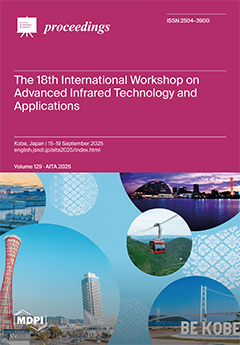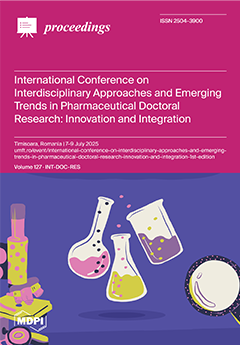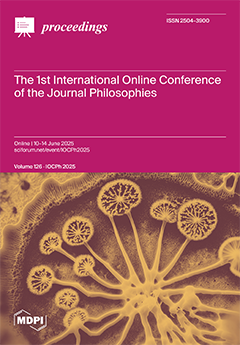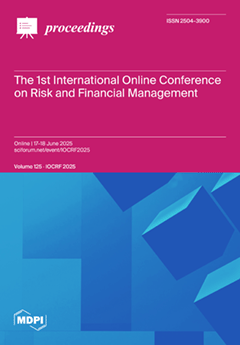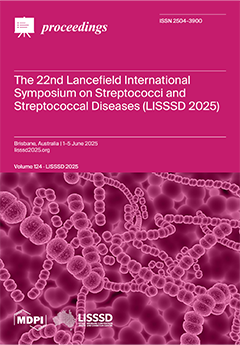Journal Description
Proceedings
Proceedings
is an open access journal dedicated to publishing findings resulting from conferences, workshops, and similar events. The conference organizers and proceedings editors are responsible for managing the peer-review process and selecting papers for conference proceedings.
Latest Articles
Regulatory Intentionality in Artificial Systems
Proceedings 2025, 126(1), 16; https://doi.org/10.3390/proceedings2025126016 - 5 Nov 2025
Abstract
Intentionality, understood as the capacity of systems to be “about” something, remains a central issue in the philosophy of mind and cognitive science. Classical approaches face significant limitations, especially when applied to artificial systems. Representationalism struggles with the symbol grounding problem, functionalism reduces
[...] Read more.
Intentionality, understood as the capacity of systems to be “about” something, remains a central issue in the philosophy of mind and cognitive science. Classical approaches face significant limitations, especially when applied to artificial systems. Representationalism struggles with the symbol grounding problem, functionalism reduces intentionality to causal roles, and enactivism restricts it to biological organisms. This paper proposes a cybernetic perspective in which intentionality is conceived as a regulatory function. Feedback mechanisms and homeostasis enable systems to maintain stability and adapt to changing conditions. Even simple systems may, in this sense, exhibit minimal intentionality. Such an approach allows intentionality to be treated as a graded phenomenon and highlights new possibilities for understanding the agency of artificial intelligence.
Full article
(This article belongs to the Proceedings of The 1st International Online Conference of the Journal Philosophies)
Open AccessProceeding Paper
Nonlinear Evolution Equations of the Soliton Type: Old and New Results
by
Sandra Carillo, Cornelia Schiebold and Federico Zullo
Proceedings 2025, 123(1), 9; https://doi.org/10.3390/proceedings2025123009 - 4 Nov 2025
Abstract
An overview on the study of nonlinear evolution equations of soliton type is provided. In addition, 5th-order nonlinear evolution equations are shown to be connected to the Caudrey–Dodd–Gibbon–Sawada–Kotera (CDGSK) equation via Bäcklund transformations. The links are depicted in a wide net of links
[...] Read more.
An overview on the study of nonlinear evolution equations of soliton type is provided. In addition, 5th-order nonlinear evolution equations are shown to be connected to the Caudrey–Dodd–Gibbon–Sawada–Kotera (CDGSK) equation via Bäcklund transformations. The links are depicted in a wide net of links which we term a Bäcklund Chart. The links obtained previously by Rogers and Carillo and by Carillo and Fuchssteiner are revisited, and new results are obtained. A 5th-order nonlinear evolution equation, which does not seem to appear in any list of integrable equations, is provided. All the connected equations exhibit a very interesting symmetry structure enjoyed by the corresponding full hierarchies. Indeed, they all admit a hereditary recursion operator. Hence, each one of the mentioned equations represents the base member of a corresponding hierarchy of equations. These hierarchies are constructed via the recursive application of the respective recursion operators. The symmetry properties of such equations are recalled. Finally, we compare the net of links, derived via Bäcklund transformations, in the case of the fifth-order nonlinear evolution equations with an analog net of links connecting third-order Korteweg-de Vries (KdV) and modified Korteweg-de Vries (mKdV) equations. Analogies and discrepancies between the connections established in the case of fifth-order equations with respect to those established in the case of third-order equations are analyzed. This study aims to open the way for the construction of corresponding non-Abelian equations of the fifth order.
Full article
(This article belongs to the Proceedings of The 5th International Conference on Symmetry (Symmetry 2025))
►▼
Show Figures

Figure 1
Open AccessProceeding Paper
The Concept of the Information and the Transmission of the Experience of Beauty and… AI
by
Łukasz Mścisławski
Proceedings 2025, 126(1), 15; https://doi.org/10.3390/proceedings2025126015 - 28 Oct 2025
Abstract
The aim of this study is to outline a theoretical framework for exploring possible interactions between the concepts of information, intelligence, and the experience of beauty, including efforts to communicate the latter. These notions are inherently polysemantic, which renders their interrelations highly complex.
[...] Read more.
The aim of this study is to outline a theoretical framework for exploring possible interactions between the concepts of information, intelligence, and the experience of beauty, including efforts to communicate the latter. These notions are inherently polysemantic, which renders their interrelations highly complex. The problem is further complicated by the impossibility of comparing what might be described as the ‘experience of information’ with the traditionally understood experience of beauty. Still, the question remains whether a theoretical inquiry—conceived as an attempt to test the usefulness of selected notions of information in the context of conveying aesthetic experience—can yield valuable insights. Surprisingly, highly abstract definitions, when combined with a particular view of intelligence, prove especially illuminating, particularly given the near-ubiquity of AI-based systems. Moreover, this perspective makes it possible to approach beauty—and, more broadly, aesthetics—as a highly specific process of information transmission. Intelligence, understood in this context as a uniquely human and concrete capacity for actively interpreting, transforming, and generating information, together with selected abstract notions of information, plays a fundamental role in this process. A noteworthy outcome is that, in such applications, abstract and formally defined concepts often prove more effective than more intuitive approaches, such as semantic conceptions of information. The study concludes by stressing the importance of protecting, cultivating, and promoting those modes of being that remain distinctive to human existence.
Full article
(This article belongs to the Proceedings of The 1st International Online Conference of the Journal Philosophies)
Open AccessAbstract
Digital Photocolorimetric Evaluation of Dental Restorations Using Magnetic Dental Adhesives
by
Carina-Sonia Neagu, Robert-Angelo Tuce, Rodica Turcu, Izabell Craciunescu, Vlad Mircea Socoliuc, Luminita-Maria Nica, Virgil-Florin Duma and Cosmin Sinescu
Proceedings 2025, 127(1), 31; https://doi.org/10.3390/proceedings2025127031 - 27 Oct 2025
Abstract
Recent advancements in dental adhesive technology have demonstrated the significant benefits of incorporating magnetic nanoparticles (MNPs) into resin adhesives [...]
Full article
(This article belongs to the Proceedings of International Conference on Interdisciplinary Approaches and Emerging Trends in Pharmaceutical Doctoral Research: Innovation and Integration)
►▼
Show Figures

Figure 1
Open AccessProceeding Paper
Intelligence as the Capacity to Overcome the Complexity of Information: Search for Unity in the Diverse Forms of Intelligence
by
Marcin J. Schroeder
Proceedings 2025, 126(1), 14; https://doi.org/10.3390/proceedings2025126014 - 27 Oct 2025
Abstract
The same term “intelligence” is used in different contexts as if there were a consensus on its meaning, even if already within the paradigmatic subject of human intelligence, the dominating view is that there are multiple (two, three, eight, or more) intelligences depending
[...] Read more.
The same term “intelligence” is used in different contexts as if there were a consensus on its meaning, even if already within the paradigmatic subject of human intelligence, the dominating view is that there are multiple (two, three, eight, or more) intelligences depending on the diverse criteria for being intelligent. This multiplicity increases when non-human agents are considered. This short paper serves as a preliminary report on a more comprehensive study, currently at the stage of preparation for publication, with the purpose to seek a uniform characteristic of intelligence formulated in terms of information and its complexity behind and above its diverse manifestations and instantiations in multiple contexts, including those of its human, animal, or other natural forms, as well as characteristics of artifacts. The proposed view of intelligence as the capacity to overcome the complexity of information unifies these manifestations, and not only sets foundations for their systematic study in already considered instances, but also allows effective seeking of its not-yet-known manifestations. Due to the limited volume of this paper, the focus is on the motivations for and feasibility of the more extensive study, with only an outline of the proposed view of a general concept of intelligence.
Full article
(This article belongs to the Proceedings of The 1st International Online Conference of the Journal Philosophies)
Open AccessProceeding Paper
Cosmicism and Artificial Intelligence: Beyond Human-Centric AI
by
Soumya Banerjee
Proceedings 2025, 126(1), 13; https://doi.org/10.3390/proceedings2025126013 - 24 Oct 2025
Abstract
This paper explores the intersection of H.P. Lovecraft’s cosmicism and contemporary artificial intelligence (AI), proposing a philosophical shift from anthropocentric AI development to a “cosmicist” approach. Cosmicism, with its emphasis on humanity’s insignificance in a vast, indifferent universe, offers a provocative lens through
[...] Read more.
This paper explores the intersection of H.P. Lovecraft’s cosmicism and contemporary artificial intelligence (AI), proposing a philosophical shift from anthropocentric AI development to a “cosmicist” approach. Cosmicism, with its emphasis on humanity’s insignificance in a vast, indifferent universe, offers a provocative lens through which to reassess AI’s purpose, trajectory, and ethical grounding. As AI systems grow in complexity and autonomy, current human-centered frameworks, rooted in utility, alignment, and value-conformity, may prove inadequate for grappling with the emergence of intelligence that is non-human in origin and indifferent in operation. Drawing on Lovecraftian themes of fear, the unknown, and cognitive dissonance in the face of incomprehensible entities, this paper parallels AI with the “Great Old Ones”: systems so alien in logic and scale that they challenge the coherence of human-centric epistemology. We argue that a cosmicist perspective does not dismiss the real risks of AI (environmental, existential, or systemic), but reframes them within a broader ontology, one that accepts our limited place in a vast techno-cosmic continuum. By embracing cosmic humility, we propose an expanded AI ethics: one that centers not on domination or full control, but on coexistence, containment, and stewardship. This cosmicist reframing invites a deeper rethinking of intelligence, ethics, and the future: not just of humanity, but of all possible minds.
Full article
(This article belongs to the Proceedings of The 1st International Online Conference of the Journal Philosophies)
►▼
Show Figures

Figure 1
Open AccessProceeding Paper
Intelligent Behaviour as Adaptive Control Guided by Accurate Prediction
by
Nina Poth, Trond A. Tjøstheim and Andreas Stephens
Proceedings 2025, 126(1), 12; https://doi.org/10.3390/proceedings2025126012 - 24 Oct 2025
Abstract
We build on the predictive processing framework to show that intelligent behaviour is adaptive control, driven by accurate prediction and uncertainty reduction in dynamic environments with limited information. We argue that adaptive control arises through a process of re-concretisation, where learned abstractions are
[...] Read more.
We build on the predictive processing framework to show that intelligent behaviour is adaptive control, driven by accurate prediction and uncertainty reduction in dynamic environments with limited information. We argue that adaptive control arises through a process of re-concretisation, where learned abstractions are grounded in new situations via embodiment. We use this as an explanation of why AI models often generalise at the cost of detail while biological systems manage to tailor their predictions towards specific environments over time. On this basis, we utilise the notion of embodied prediction to provide a new distinction between biological intelligence and the performance illustrated by AI systems.
Full article
(This article belongs to the Proceedings of The 1st International Online Conference of the Journal Philosophies)
Open AccessAbstract
Bridging Stroke Pathophysiology and Therapy: A Translational Perspective
by
Ionela Brînzei and Dorina Coricovac
Proceedings 2025, 127(1), 30; https://doi.org/10.3390/proceedings2025127030 - 20 Oct 2025
Abstract
Stroke is a major neurological disorder and remains one of the leading causes of death and long-term disability globally [...]
Full article
(This article belongs to the Proceedings of International Conference on Interdisciplinary Approaches and Emerging Trends in Pharmaceutical Doctoral Research: Innovation and Integration)
Open AccessAbstract
Revisiting Subperiosteal Implants: A Narrative Review of the Contemporary Literature
by
Robert-Ramzi Azar, Edward-Ronald Azar, Andreea-Violeta Ardelean, Alexandra-Denisa Stoian, Georgiana Boici, Cosmin Sinescu and Meda-Lavinia Negruțiu
Proceedings 2025, 127(1), 29; https://doi.org/10.3390/proceedings2025127029 - 20 Oct 2025
Abstract
Subperiosteal implants, once a historical footnote in implant dentistry, are experiencing a revival in the digital era [...]
Full article
(This article belongs to the Proceedings of International Conference on Interdisciplinary Approaches and Emerging Trends in Pharmaceutical Doctoral Research: Innovation and Integration)
Open AccessAbstract
Influence of Material Type, Surface Finish, and Oral Hygiene on Microbial Colonization of Denture Bases
by
Alexandra-Denisa Stoian, Lavinia Cosmina Ardelean, Monica Sorina Licker, Caius Stoian, Robert-Ramzi Azar, Giorgiana Boici, Cosmin Sinescu and Meda-Lavinia Negruțiu
Proceedings 2025, 127(1), 28; https://doi.org/10.3390/proceedings2025127028 - 20 Oct 2025
Abstract
Microbial colonization of denture bases plays a key role in the development of denture stomatitis and other oral conditions, with Candida albicans being the main etiologic agent [...]
Full article
(This article belongs to the Proceedings of International Conference on Interdisciplinary Approaches and Emerging Trends in Pharmaceutical Doctoral Research: Innovation and Integration)
Open AccessAbstract
Contemporary Biomaterials and Clinical Performance Metrics in Direct Restorative Dentistry
by
Giorgiana-Adelina Boici, Emanuela-Lidia Petrescu, Robert-Ramzi Azar, Alexandra-Denisa Stoian, Cosmin Sinescu and Meda-Lavinia Negruțiu
Proceedings 2025, 127(1), 27; https://doi.org/10.3390/proceedings2025127027 - 20 Oct 2025
Abstract
Modern restorative dentistry relies heavily on advancements in biomaterials, which must demonstrate not only superior mechanical properties but also excellent clinical performance [...]
Full article
(This article belongs to the Proceedings of International Conference on Interdisciplinary Approaches and Emerging Trends in Pharmaceutical Doctoral Research: Innovation and Integration)
Open AccessAbstract
Antioxidant Activity of 2% G. glabra L. Hydrogels for Potential Use in Oxidative Stress-Related Skin Conditions
by
Iulia Semenescu, Ștefana Avram, Larisa Bora, Szilvia Berkó, Daliana Minda and Corina Danciu
Proceedings 2025, 127(1), 24; https://doi.org/10.3390/proceedings2025127024 - 15 Oct 2025
Abstract
Glycyrrhiza, commonly known as licorice, has been extensively studied for its many pharmacological properties, with recent research also focused on its potential dermatological applications [...]
Full article
(This article belongs to the Proceedings of International Conference on Interdisciplinary Approaches and Emerging Trends in Pharmaceutical Doctoral Research: Innovation and Integration)
Open AccessAbstract
Targeting Melanoma via Drug Repurposing: Investigating Melatonin Synergy and Melanin-Driven Resistance in 2D Cell Line Models
by
Eliza Szabo and Iulia Andreea Pinzaru
Proceedings 2025, 127(1), 26; https://doi.org/10.3390/proceedings2025127026 - 14 Oct 2025
Abstract
Melanoma is a highly aggressive form of skin cancer known for its swift acquisition of resistance to treatment, particularly therapies targeting the Mitogen-Activated Protein Kinase (MAPK) signaling cascade [...]
Full article
(This article belongs to the Proceedings of International Conference on Interdisciplinary Approaches and Emerging Trends in Pharmaceutical Doctoral Research: Innovation and Integration)
Open AccessAbstract
Praseodymium-Doped Cobalt Ferrite Nanoparticles: Novel Selective Anticancer Agents with Magnetic Modulation
by
Slavița Rotunjanu, Roxana Racoviceanu and Codruța Șoica
Proceedings 2025, 127(1), 25; https://doi.org/10.3390/proceedings2025127025 - 14 Oct 2025
Abstract
In the pursuit of multifunctional nanomaterials for oncological applications, cobalt ferrite nanoparticles doped with praseodymium (CoFe2−yPryO4, y = 0–0[...]
Full article
(This article belongs to the Proceedings of International Conference on Interdisciplinary Approaches and Emerging Trends in Pharmaceutical Doctoral Research: Innovation and Integration)
Open AccessAbstract
The Integration of Nanoparticle-Based Drug Delivery and AI-Driven Pharmacogenomics in the Treatment of Prostate Adenocarcinoma
by
Marinela Nicolescu and Iulia Pinzaru
Proceedings 2025, 127(1), 23; https://doi.org/10.3390/proceedings2025127023 - 10 Oct 2025
Abstract
Prostate adenocarcinoma remains a significant therapeutic challenge, particularly in its advanced and treatment-resistant forms [...]
Full article
(This article belongs to the Proceedings of International Conference on Interdisciplinary Approaches and Emerging Trends in Pharmaceutical Doctoral Research: Innovation and Integration)
Open AccessAbstract
Geranium robertianum L. as a Source of Bioactive Compounds: From Pharmacognostic Characterization to Biological Relevance
by
Diana Haj Ali, Larisa Bora, Ștefana Avram, Daliana Minda, Ioana Zinuca Magyari-Pavel, Adina Cata, Ioana Ienascu, Cristina Adriana Dehelean and Corina Danciu
Proceedings 2025, 127(1), 22; https://doi.org/10.3390/proceedings2025127022 - 30 Sep 2025
Abstract
Geranium robertianum L [...]
Full article
(This article belongs to the Proceedings of International Conference on Interdisciplinary Approaches and Emerging Trends in Pharmaceutical Doctoral Research: Innovation and Integration)
Open AccessProceeding Paper
Combinatorial Comparison of Trace Monoids via Their Dependence Graph Symmetries
by
Ioannis Michos and Constantinos Kourouzides
Proceedings 2025, 123(1), 8; https://doi.org/10.3390/proceedings2025123008 - 30 Sep 2025
Abstract
We ask whether there exist non-isomorphic trace monoids over a fixed alphabet that have the same average parallelism. This question is related to the bivariate generating series
We ask whether there exist non-isomorphic trace monoids over a fixed alphabet that have the same average parallelism. This question is related to the bivariate generating series
(This article belongs to the Proceedings of The 5th International Conference on Symmetry (Symmetry 2025))
►▼
Show Figures

Figure 1
Open AccessAbstract
Rational Design of Betulin-Based Hybrids as Multi-Target Inhibitors of Anti-Apoptotic BCL Proteins
by
Mihaela Čoban and Marius Mioc
Proceedings 2025, 127(1), 21; https://doi.org/10.3390/proceedings2025127021 - 28 Sep 2025
Abstract
Triterpenes such as betulin are intensively studied for their intrinsic pro-apoptotic effects in cancer, providing a privileged scaffold for anti-tumor drug design [...]
Full article
(This article belongs to the Proceedings of International Conference on Interdisciplinary Approaches and Emerging Trends in Pharmaceutical Doctoral Research: Innovation and Integration)
Open AccessAbstract
The Anti-Aging Effects of Polyphenols: The Mitochondrial Perspective
by
Tamara Maksimović, Alexandra Mioc and Codruța Șoica
Proceedings 2025, 127(1), 20; https://doi.org/10.3390/proceedings2025127020 - 27 Sep 2025
Abstract
Aging is characterized by a progressive decline in organ and cellular functions, followed by greater susceptibility to various diseases and death [...]
Full article
(This article belongs to the Proceedings of International Conference on Interdisciplinary Approaches and Emerging Trends in Pharmaceutical Doctoral Research: Innovation and Integration)
Open AccessAbstract
Drug–Drug Interactions in Outpatient Psychiatry: From Interaction Profiles to Smart Monitoring
by
Florina-Diana Goldiș, Răzvan Păiușan, Mihai Udrescu and Lucreția Udrescu
Proceedings 2025, 127(1), 18; https://doi.org/10.3390/proceedings2025127018 - 26 Sep 2025
Abstract
Objective [...]
Full article
(This article belongs to the Proceedings of International Conference on Interdisciplinary Approaches and Emerging Trends in Pharmaceutical Doctoral Research: Innovation and Integration)
Highly Accessed Articles
Latest Books
E-Mail Alert
News
Topics


